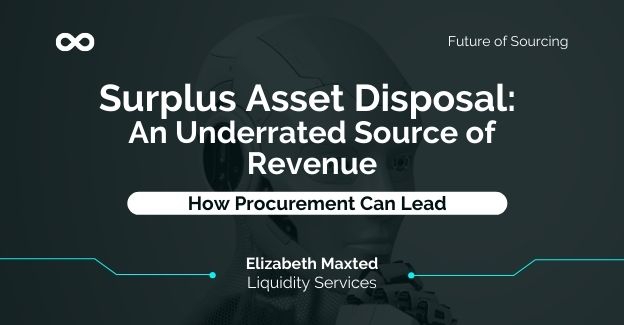Companies are facing shortages and complexities in their supply chains, but surplus assets don’t have to be part of the cost structure, says Elizabeth Maxted, Vice President and General Manager of Liquidity Services. She shares how procurement teams can implement new ways to capitalize on obsolete equipment and unused machinery.
The global supply chain has been stretched and disrupted like never before, putting a significant burden on shippers, manufacturers, retailers and consumers. Dealing with shortages of so many formerly abundant items has prompted many businesses to shift their focus to reusing merchandise and equipment.
In a world of supply shortages, it might seem strange to think that some companies are seeing surplus, but the reality is that businesses are constantly generating surplus assets. At a time when many businesses’ procurement teams are struggling with shortages and paying a premium to get suitable machinery, inventory, or inputs supplied to their organizations, companies are leaving money on the table by not recognizing the opportunity presented by their surplus assets.
In truth, surplus asset disposal is a massively underrated revenue generation opportunity. With the right process, an organization can transform surplus assets from a logistical problem or storage cost to a new source of working capital.
Let’s take a closer look at how surplus asset disposal can drive business value for your company.
Surplus Assets: Where Do They Come From?
According to data from the Investment Recovery Association, the average organization carries a 15% to 20% surplus in its supply chain at any time. For retailers, this surplus could be in the form of returned consumer goods or overstock inventory. For industrial manufacturers, this might be surplus equipment and machinery. Government agencies might have surplus fleet vehicles, buildings or real estate. In short, surplus is a reality for every industry.
No matter how efficient your organization tries to be, surplus assets accrue for valid reasons. Whether it’s a change in business strategy, environmental footprint, technology or consumer behavior, businesses will always end up with surplus capital assets, obsolete machinery, unsellable inventory or equipment they cannot use.
Surplus Assets Aren’t Free: The Cost of Holding on to Obsolete Equipment
One challenge in dealing with surplus assets is that companies often manage them in a fragmented way. As a result, surpluses sometimes develop on an ad hoc basis – such as when site managers decide to handle surplus assets at the local level without a larger strategy or organization-wide protocol in place.
Without a plan, companies often resort to liquidating those assets, resulting in additional costs and lower financial returns. Businesses routinely lose out by selling items for much less than what they could've gotten for them had they sold through the secondary marketplace.
Another challenge is when multiple stakeholders within the company have different priorities for surplus assets. For example, engineers may want to hold on to idle equipment in case it may be useful in the future, but this way of thinking doesn’t consider the costs of holding surplus assets – such as the ongoing cost of ownership, taxes, depreciation and overhead for storage.
Contrast that with another stakeholder—facility managers. They often want to dispose of surplus capital assets as quickly as possible because the old equipment can take up valuable space. What these stakeholders may not realize is that a company may miss out on higher returns by offloading surplus assets hastily. Oftentimes, assets identified as “scrap” are, in fact, sellable.
Organizations need to take a different approach to their surplus assets. Holding on to obsolete equipment or other surplus items requires the company to bear the cost of assets that are no longer productive, and ultimately hurts the company’s bottom line.
Conversely, disposing of surplus capital assets by selling them to the first low-bidding local buyer isn’t a good strategy either; these assets still have value, even if they no longer fit into an organization’s long-term plans. Instead, consider selling assets on a larger market; one company’s retired and obsolete machinery is another company’s opportunity.
When a procurement team takes a disciplined, strategic approach to surplus, it will ensure the organization gets the most value from its surplus assets. This type of leadership turns a cost into cash for the organization.
Why Procurement Should Lead Your Surplus Asset Initiatives
Procurement professionals tend to be highly organized, work with the mindset of upgrading technologies while managing costs and bring a structured approach to building scalable processes. As a result, when a procurement team tackles surplus asset challenges, a company is more likely to develop a standard surplus management procedure that can be applied to all facilities throughout the organization.
Procurement teams are also good at partnering with other internal functions: they can talk to the finance team about the depreciation of surplus assets, reducing the book value, and taking it to the external market, pushing the selling process along where it may have otherwise stalled. In addition, they have the power to connect surplus asset programs to sustainability initiatives – there are ample opportunities to use surplus disposal to promote the circular economy, reduce carbon emissions and show a company’s leadership in going green.
Currently, less than 30% of companies have surplus programs run by procurement teams; this is another overlooked opportunity. Instead of leaving surplus assets to be managed by local facility managers or engineering teams, put procurement in charge. Procurement teams have the right skills, experience and perspectives to maximize an organization’s value when liquidating surplus assets.
Another benefit of having procurement in charge of surplus asset disposal is their holistic view of the life cycle of equipment, from the purchasing of new equipment to the retirement of assets. As procurement teams buy new equipment to outfit and upgrade facilities, they should also plan for which assets the company is planning to sunset to make room for those upgrades. Procurement leaders are well-equipped to create a disposition path for the obsolete equipment while replacing it.
Companies are facing shortages and complexities in their supply chains, but surplus assets don’t have to be part of the cost structure. Instead, they can be an opportunity for revenue generation. Rather than treating surplus assets as an unsolvable problem, or an ad hoc afterthought, proactive retirement planning can transform these items into what they truly are: assets, not costs. Procurement teams have the tools and knowledge to implement a new way to capitalize on obsolete equipment and unused machinery.








